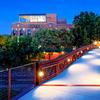The cost of the land in Phoenix, Ariz., and the value for what they would get just wasn’t adding up to developer Bill Wichterman and his partners.
So, in 2005, they gave up on building their commercial mixed-use development project there. But, a year later, they settled on a new site for Porteos: Aurora, near Denver International Airport.
Wichterman’s group wasn’t the only one with that idea. Around the same time, other developers from Arizona bought acreage around the airport, the 10th busiest airport in the country at the time. Meanwhile, groups in Arizona were purchasing land around a much smaller airport, and paying nearly five times per square foot what Wichterman’s group paid in Aurora.
“We all focused on Colorado and the area around the airport because we figured that was going to be definitely the path of future growth,” Wichterman, president of The San Juan Company, said.
Almost two decades later, he was proven right. Aurora, east of Denver, is the state’s third-largest city with almost 390,000 residents, according to population estimates by the U.S. Census Bureau, and more than 450 neighborhoods. The city is spreading further east, as a number of residential, commercial and industrial developments are built, as evidenced by the city’s growing list of planned projects.
More than 2,000 new general business licenses were granted in Aurora this year, according to city data.
Porteos, the development Wichterman is working on, is at the northeast corner of Jackson Gap Street and 56th Avenue, and includes a variety of sectors, with retail, restaurant, hotel, office, industrial and aviation site plans. Several of the buildings have already gone up, and he expects most of the infrastructure to be completed in 2024.
“The growth in Aurora, especially the Gaylord (Rockies and Convention Center), it’s really positive. It’s only gotten better than it was. … We’ve helped make the neighborhood better by spending millions of dollars on infrastructure, but everyone in the whole area around us has really picked up its game as well, which is good for all of us,” Wichterman said.

Part of that reason can be attributed to the amount of space available, as 38.6% of the city’s land is undeveloped, according to city officials.
The Gaylord Rockies Resort & Convention Center, a five-star hotel at 6700 N. Gaylord Rockies Blvd., has construction pending for a 20% expansion of the property, which sits at almost 2 million square feet, Jason Batchelor, Aurora deputy city manager, said.
Major projects are already underway at the Majestic Commercenter, a 1,600-acre business park. Its tenants include corporate giants, such as Amazon.com Inc., FedEx Corporation and Anheuser-Busch Companies LLC, according to its website.
Once hosting three active military bases, the city saw a spike in growth in the mid-20th century during the post-war years. Now, not only does Aurora attract military and defense contractors, but it’s also drawing in medical professionals and corporate workers hoping to live closer to their offices.
“We’ve continued to see strong growth,” Batchelor said. “We think we’ll probably tip over 400,000 (people) here sometime in the next few months, next year.”
Aurora also takes the title of the most diverse city in Colorado, a place that many immigrants call home. More than 20% of its residents were born outside of the U.S. About 28% of residents identify as Hispanic, nearly 17% as Black and 7.5% as two or more races. More than 23,500 veterans also live in the city.
Over the past eight years, some residents from other Denver area communities have also moved to Aurora, which was historically seen as a more affordable market in the region, particularly because of gentrification and residents being priced out of their original homes, Batchelor said.
As Coloradans continue to face challenges with high housing costs and available inventory, there are several major residential projects in the works in Aurora, including the Painted Prairie Community and The Aurora Highlands. Both are in the process of expanding, Batchelor said.

Painted Prairie, a housing development at 6000 Picadilly St., consists of 400 completed units out of 4,200 planned. It spans more than 600 acres and is minutes from Denver International Airport, with additional phases under construction, Batchelor said. The Aurora Highlands at 3900 E-470 has even more in store, with around 360 units permitted or under construction and more than 12,000 units planned.
With Wichterman’s commercial project, the developers got together with property owners in the area, along with the city and the Aurora Economic Development Council, to form a taxing authority to build out 64th Avenue from E-470 to Jackson Gap. He said the completion of that road “will really change the complexion of the area.”
Aurora’s seeing more development — particularly near DIA — because of heightened residential demand and the limited housing supply in the Denver area, said Justin Hunt, senior vice president at CBRE, who specializes in multi-family property sales. Notably, he pointed out an influx of Californians migrating to the Denver area.
Another factor at play is the Denver area’s geography, Hunt said. For instance, the western municipalities, including Golden and Lakewood, have less land to develop, given their proximity to the mountains.
In the past, it was more expensive to build in Aurora than Denver because of fees, but the playing field is leveling out, so “you’re starting to see some developers shift their eyes closer to Aurora,” Hunt added.
City officials said they’ve worked to make Aurora business friendly, making changes, such as eliminating some fees and licensing requirements via recommendations from the recently-formed Red Tape Reduction Ad Hoc Committee. They’ve also sped up permitting processes to attract more businesses.
City Councilwoman Danielle Jurinsky, a business owner and chair of the Planning and Economic Development Policy Committee, said to attract more developers to areas with new homes in eastern Aurora and other parts of the city, they need to know they’ll have an anchor tenant — a prominent store or chain to attract visitors — or other retailers interested in the property. That’s important for residents, so they aren’t driving 40 miles away to get to the nearest shopping center, Jurinsky said.
“I want everybody to have a stake in Aurora — if they’re a mom-and-pop business or if they are one of the more prominent developers, I want everybody in communication with what’s going on,” she said.
Jurinsky, a lifelong Aurora resident, said “business feeds business.” For example, one of the bars she owns in the city is close to an auto shop. People often drop their cars off and visit the bar to grab a beer as they wait. She hopes some of the changes the city is making and increased communication will attract more developers and owners to the area.
Related Articles
-
Passenger killed in single-vehicle crash in Aurora
-
Getting convicted of stealing a car in Aurora will soon mean more jail time
-
New camera system in Aurora will soon catch speeding drivers and issue tickets
-
A new brewery called Second Dawn is coming to Aurora near the Stanley Marketplace
-
Aurora police seek witnesses after 20-year-old woman brought to hospital with fatal gunshot wound
Since Jan. 1, 2018, the Aurora Economic Development Council reports that it has helped create or retain more than 10,000 primary jobs through more than 60 deals and more than 37,000 jobs since 2001, making up a quarter of Aurora’s workforce.
“Projects like Intel’s in Columbus, Lego’s in Virginia, Panasonic’s in Kansas City, Rivian’s in Atlanta, and TSMC’s in Phoenix are all examples of transformational deals we’re seeking to attract here,” council Vice President Yuriy Gorlov said.

The council focuses on targeting development that works toward “building on the assets we already have,” Gorlov said, adding economic development takes time. For example, the Fitzsimons Innovation Community Campus, which is the CU Anschutz campus’ health sciences facility, moved to eastern Aurora almost 20 years ago and is now expanding, he said.
As the Denver area grew, Aurora was viewed as “this next frontier” with industrial companies, he added, noting that Amazon’s first facility in Colorado came to Aurora.
“We are adjacent to a lot of major transportation corridors; we generally have more ‘attainable,’ as we like to call it, but basically affordable land prices, real estate prices,” Gorlov said.
That, coupled with diverse talent from various industries, has led to where Aurora is in 2022, Gorlov said.
Employers and developers choosing Aurora started to ramp up in 2018, especially with projects like the Gaylord, Porteos, Port Colorado and the Colorado Air and Space Port (formerly Front Range Airport). Plus, many people realized it’s “not all about central business districts in big cities,” especially during the COVID-19 pandemic, Gorlov said, but they could take advantage of “outer-ring” cities like Aurora, which he called a “city of commerce.”


